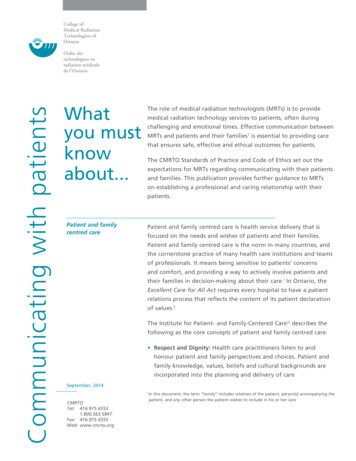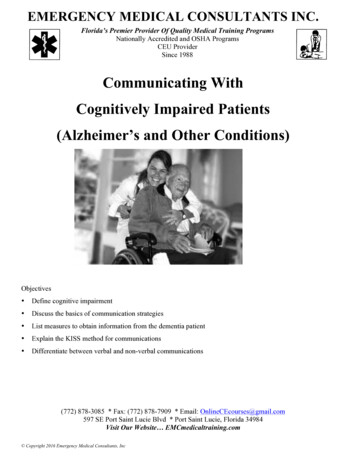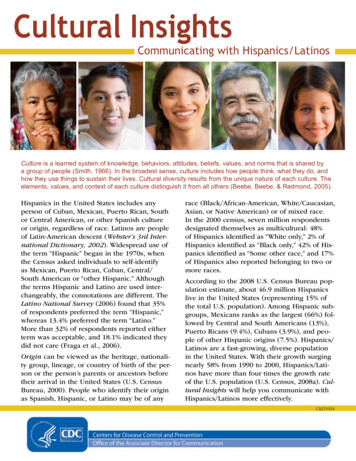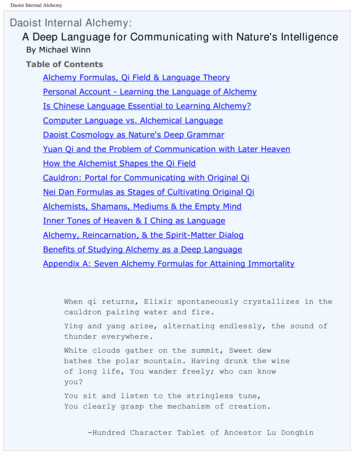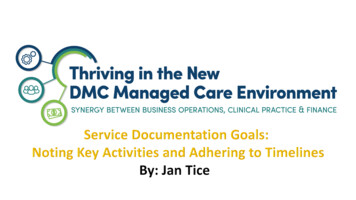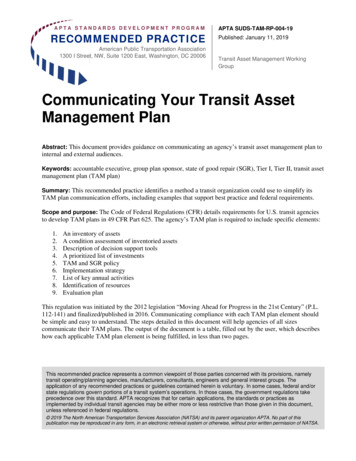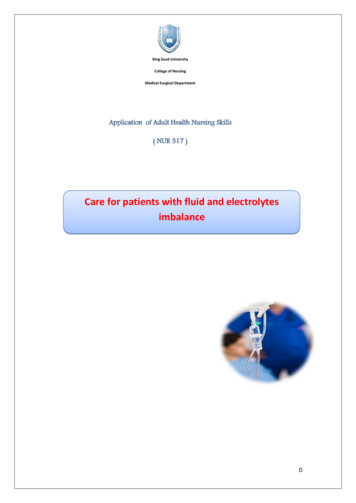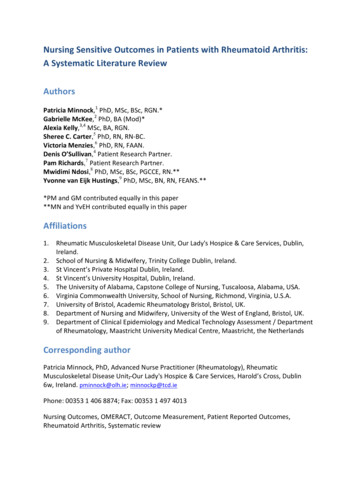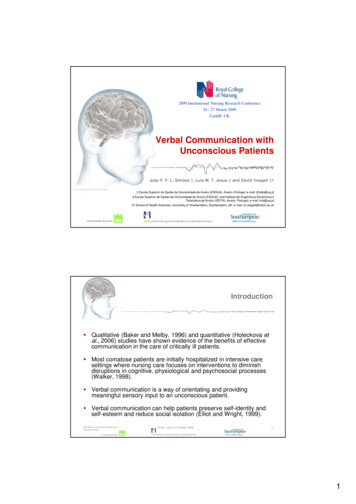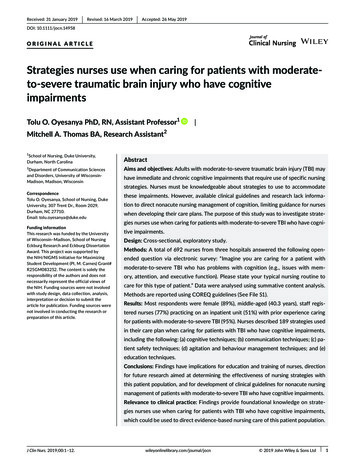
Transcription
s p e c i a la r t i c l eCommunicating with Patients WhoHave Limited Literacy SkillsReport of the National Work Group on Literacy and HealthThe National Work Group on Literacy and Health*Between 40 and 44 million persons in the United Statestransmitted to patients in ways that make it understand have rudimentary literacy skills, and are unable to under able to poor readers. However, it is not known if usingstand written materials that require only basic readingspecial low-literacy education materials with theseproficiency. The purpose of this report is to characterizepatients improves health outcomes.the current status of illiteracy in the United cribe the relationship between poor literacy and poorpatients is essential, materials should be at the 5th-gradehealth, and make recommendations on how to deal withlevel or lower, supplemented by nonwritten communica patients who have poor reading skills.tion. Simple and nonwritten materials are appropriate forData collected by the National Work Group on Literacypersons with limited literacy, and also for those with well-and Health indicate that one quarter of the US populationdeveloped literacy. Research is needed to clarify thehas rudimentary reading skills, and another 25% has lim mechanisms through which illiteracy influences healthited reading skills. This makes it difficult to have writtenstatus and health services utilization, and to determine ifcommunication with much of the US population. Poorusing low-literacy health education materials improvesreading skills are associated with poor health and greaterhealth outcomes.use of health services, but the basis for this association isunclear. Instruments are available to measure patients’K ey W ords. Literacy; illiteracy; health status; patient ed reading skills in clinical settings, and information can beucation; communication. (J Fam Pract 1998; 46:168-176)n 1992, the National Cancer Institute (NCI), inpartnership with the AMC Cancer ResearchCenter in Denver, established the NationalWork Group on Cancer and Literacy (NW G).The NWG was created to focus national atten tion on the need for more effective communicationwith individuals who have limited literacy skills, andto provide the NCI with recommendations about thebest ways to communicate with such individuals.The NWG consisted o f 30 individuals from the fieldso f education, cancer control, health communica tions, medicine, nursing, epidemiology, public policy,and international health.The findings o f the group, presented in this docu ment, indicate that limited literacy has implicationsnot just for cancer, but for all areas o f health.Accordingly, in 1996, the group was renamed theNational Work Group on Literacy and Health.1Thisreport summarizes research reviewed and informa tion collected by NWG members, and reports theNW G’s recommendations for dealing with issuesrelated to literacy and health.I*See Acknowledgments f o r list o f individuals who participat ed as authors.Submitted, revised, October 23, 1997.F or information about the National Work Group on Literacyand Health, contact Laurie Schneider, MPH, AMC CancerResearch Center, 1600 Pierce Street, Denver, CO 80212.Phone: 303-239-3405; fa r : 303-233-1863; E-mail:schneiderl@amc. org.Requests f o r reprints should be addressed to Barry D. Weiss,MD, University o f Texas Health Science Center at SanAntonio, 7703 Floyd Curl Drive, San Antonio, TX 782847794. E-mail: bdweiss@uthscsa.edu.168 The Journal o f Family Practice, Vol. 46, No. 2 (Feb), 1998C U R R E N T STATUS O F L IT E R A C Y INT H E U N IT E D STATESIn recent years, it has become apparent that poor lit eracy is a widespread problem in the United States.Overall, the average reading skills o f adultAmericans is between the skills levels o f grade 8 andgrade 9,2 and the reading skills o f Medicaid partici pants are at about the 5th-grade level.3The most definitive study o f the prevalence o f illit eracy was the 1993 National Adult Literacy Survey(N A LS ), conducted by the US Department of 1998 A ppleton & Lange/ISSN 0094-3509
PATIENTS WITH LIMITED LITERACY SKILLSEducation.4 NALS investigators tested 26,000 USadults, and categorized their English-language litera cy skills into five functional levels by assessing abili ties to read and understand prose, informationaldocuments, and quantitative materials.NALS data indicate that between 40 and 44 mil lion people (approximately one quarter o f the USadult population) are at the lowest level o f literacy.These individuals have only rudimentary literacyskills, and are often unable to understand writtenmaterials that require very basic reading proficiency.For example, persons in this lowest level o f literacywould likely be unable to read and understanddosage instructions on medication bottles, poisonwarnings or directions for use on a bottle o f house hold cleaning chemicals, notes from their child’steacher, a newspaper, or a city bus schedule.Individuals in the lowest literacy group are het erogeneous. Sixty-two percent did not complete highschool, 66% are age 65 or older, and 25% are immi grants who may have only just begun to learnEnglish. Persons o f lower socioeconomic status areoverrepresented. While a disproportionate numberare members o f minority groups, the largest numberare white and US-bom.3THE R E L A T IO N S H IP B E T W E E NL IT E R A C Y A N D H E A L T HStudies over several decades have demonstratedthat in nonindustrialized nations, improved literacyskills o f a population are associated with betterhealth status and higher levels o f participation inpreventive health behaviors, including participationin cancer screening.513 Most o f these studies havefound that improved population literacy is indepen dently correlated with improved health status, evenwhen confounding variables such as income, educa tion level, employment, and nutritional status aretaken into account.It is conceptually and methodologically difficult,however, to disentangle the contributions o f literacy,as compared with the contributions o f other associ ated sociodemographic variables, to the health sta tus o f individuals or populations.14Only three studiesdesigned specifically to examine the relationship o fliteracy level to health status have been performed inthe United States. Each o f these studies yielded sim ilar results.The first study o f low-level readers enrolled inadult basic education classes in Arizona16found thatsubjects with the poorest reading skills had poorerphysical and psychological health, as measured withthe Sickness Impact Profile,16than subjects with bet ter reading skills. These relationships persisted, evenafter statistical adjustments were made for con founding covariables such as age, income, educationlevel, ethnic background, and others. SicknessImpact Profile scores o f the lowest-level readers(those who read at the skills levels o f grade 0 tograde 3) were in the range found in persons withserious chronic illnesses.Another study in Arizona evaluated more than 400randomly selected Medicaid participants,3 includingthose who read in either Spanish or English.Unpublished data from this study reveal that amongthe subgroup o f Medicaid enrollees classified asmedically needy or medically indigent, those withvery low literacy skills had markedly higher healthcare costs than subjects with more well-developedliteracy skills. For those who read at the lowestgrade levels (grade equivalent reading level 0 to 2),the average annual health care cost was 12,974,compared with 2,969 for the overall populationstudied. The findings w ere notable because byincluding only Medicaid enrollees, the researchdesign provided inherent control for income andemployment status.A more recent study by Baker et al17involved sub jects at an urban, public hospital in Atlanta. Theresearchers measured health care utilization o f 958subjects over a 2-year period. Individuals with thelowest level o f reading skills (grade levels 0 to 3) hadan average o f 2.3 more outpatient visits per year, anda 52% greater likelihood o f hospitalization, than didthose with adequate literacy skills. Increasing use o fservices among those with low literacy skillsoccurred even among individuals who reported hav ing a regular source o f health care. Those with poorliteracy skills were more likely to report their healthstatus as poor. The findings persisted after adjust ment for potentially confounding sociodemographicvariables.Despite these limited but remarkably consistentresults linking low literacy to poor health and higherhealth services use, the mechanisms by which poorliteracy is associated with poorer health status arenot clear. The relationship is not likely to be directlycausal, in that the inability to read does not auto matically make the person ill. Rather, low literacy isThe Journal o f Family Practice, Vol. 46, No. 2 (Feb), 1998169
PATIENTS WITH LIMITED LITERACY SKILLSprobably a marker for some other unmeasured, butco-varying, factor or behavior. However, as the rela tionship between low literacy and health status per sists even when study designs control or makeadjustments for sociodemographic characteristics, itis not simply a matter o f illiteracy serving as a mark er for some other sociodemographic factor.Instead, a variety o f other mechanisms have beenproposed to explain the linkage between illiteracyand health. For example, it has been suggested thatpersons with poor literacy skills may lack a sense o fself-empowerment or self-efficacy, and be unable tomaster the assertiveness necessary to successfullynegotiate their w ay through our increasingly com plex and bureaucratic health care system.1819 Poorreaders have less knowledge about their chronic ill nesses than do those who read at higher levels,20andthis low er knowledge may somehow contribute topoorer outcomes. It also possible that low literacy isa marker for behaviors that predispose to illness, orthat individuals with low literacy may fail to under stand written information they receive from healthcare providers, thereby contributing to noncompli ance, errors in treatment, and poor outcomes.21Moreresearch is needed to clarify the mechanisms bywhich poor literacy skills are associated with poorhealth status.C O M M U N IC A T IN G W IT H P A T IE N T SW H O HAVE L IM IT E D L IT E R A C Y SK IL L SC urrent W ritten Patient E ducationM aterialsGiven the limited reading skills o f many adultAmericans, it is perhaps surprising that professionalhealth organizations distribute materials to patientsthat require advanced reading skills for comprehen sion. The reading level o f consent forms for researchprojects, cancer trials, and invasive procedures aretypically written at the college or graduate schoollevel.22*27This suggests that true informed consent isdifficult to achieve among persons with low literacyskills when currently available written materials areused. While efforts are underway to develop meth ods for enhancing the readability o f informed con sent documents through use o f simplified languageand formats,2'""i0 recent legal opinions indicate thathealth providers could be held liable for failure o finformed consent if pertinent information is not pre sented in a w ay that patients can understand.31170 The Journal o f Family Practice, Vol. 46, No. 2 (Feb), 1998Similarly, investigators have found that highlydeveloped reading skills are required for compre hension o f most patient information brochures, pam phlets, and handouts, regardless o f the topic or clin ical content. Studies o f widely available patient edu cation materials indicate that they are written at the10th grade level or higher,3245 though some morerecent materials are being written at low er readinglevels (Appendix A ). Thus, much printed health edu cation material, as well as consent forms, might beunusable by individuals who have low reading skills.In fact, because the average American’s reading skillis at the 8th to 9th grade level, much written healthinformation might not be understood even by thosewith average reading ability. This issue is o f particu lar concern for at-risk populations such as the poorand the elderly, for whom research indicates thatsubstantial proportions o f patients do not under stand written materials given to them by clinicians.16Several national accrediting agencies now requirethat health care providers ensure that patientsunderstand the medical information they are given.For example, the 1995 National Committee forQuality Assurance (NC Q A) guidelines include provi sions that focus on the reading level o f written mate rials provided to clientele o f managed care organiza tions.47 The Joint Commission on Accreditation ofHealth Care Organizations (JCAHO), in itsAccreditation Manual fo r Hospitals, now requiresthat hospitals establish a mechanism to determine iftheir informed consent procedures, medication anddischarge instructions, and other communicationscan be understood by patients. Legal experts inter pret these requirements to mean that ignoringpatients’ literacy levels may cause an institution tofall below the level o f required care.31 Implicit in thenew JCAHO directives is the importance o f assess ing patients’ learning needs to ensure a good matchbetween health care providers’ educational messageand patients’ reading skills. This may require thathealth care providers quantify the literacy skills oftheir clientele.P ractical A ssessmentC linical SettingsofL iteracy inHealth professionals often do not realize that theirpatients cannot understand written material. Littleor no information about this issue is included inmedical school curricula, and the possibility thatpatients cannot read is frequently not considered in
PATIENTS WITH LIMITED LITERACY SKILLSroutine clinician-patient interactions.49It is important for health care providers not toassume that they can recognize patients with poorliteracy skills, because most individuals with limitedliteracy try to hide the fact that they cannot read.Clinicians have reported numerous strategies usedby their patients to hide a lack o f reading ability,including use o f statements such as “I forgot myreading glasses,” “I don’t need to read this throughnow; I’ll read it when I get home,” or “I’d like to dis cuss this with my family first. May I take the instruc tions home?”60Therefore, some experts recommend directassessment o f the literacy skills o f either individualpatients or o f the patient populations o f health carefacilities. Either approach is reasonable, dependingon the needs o f the practice. Others recommend nottesting patients’ reading skills, but instead using sim ple low-literacy materials for all patients in the prac tice, regardless o f their reading skills. Still othersadvocate using nonwritten materials. Each o f theseapproaches has merit, and there is no current con sensus about which is preferable.Testing All Patients. In some practices, alladult patients undergo testing with a rapid literacy screening instrument. As described later in thispaper, these tests take only a few moments to admin ister. To avoid embarrassment to patients, a commonroutine is for a member o f the nursing staff to admin ister the screening test in the examination room afterrecording vital signs and collecting other informa tion. The patient can be told that the doctor hasheard that some patients are having trouble under standing medical forms and brochures and, there fore, the doctor wants to know the patients’ readingskills so that appropriate patient education materialscan be used.Testing a Sample o f Patients. Others recom mend testing a random sample o f patients in a prac tice to determine the general reading skills o f thepractice population. This approach provides clini cians with information about the average level andrange o f reading levels among their patients, so thateducational materials can be targeted to the prac tice’s patient population as a whole. This kind o f test ing can be performed by nurses at check-in, accom panied by the same explanation described above.Testing Instruments. For purposes o f assessingthe literacy skills o f patients, clinicians usually wantinstruments that will quickly provide a general mea sure o f reading skill. Most instruments used in clini cal settings rely on a patient’s ability to read and pro nounce written words or text. Two o f the most com monly used word recognition tests are the WideRange Achievement Test-Revised (WRAT-R-III) andthe Rapid Estimate o f Adult Literacy in Medicine(REALM ). Information on ordering these w ordrecognition tests is provided in Appendix B. Other,more complex instruments, such as those used inthe NALS survey, are also available.The WRAT-R-III61 is a nationally standardizedword recognition test, used predominantly for chil dren, that categorizes word recognition ability intograde equivalents ranging from less than a 3rd gradelevel to more than a 12th grade level. It takes 2 min utes to 3 minutes to administer and score the WRATR-III, though inexperienced examiners may requiremore time.The REALM62 is a word recognition test that wasspecifically designed for adults in health care set tings; it evaluates the ability to recognize and pro nounce medical words. The REALM can be adminis tered with very little training and can categorize anindividual’s word recognition skills into high, medi um, or low levels. The REALM can be administeredin less than 2 minutes, though total test time, if oneincludes explaining the testing procedure topatients, may be somewhat longer. Many memberso f the NWG are in favor o f the REALM because thewords used in the test are medical in nature, makingit more appropriate for evaluating literacy in a med ical setting.Simple, psychometrically tested literacy tests arenot generally available to US clinicians in languagesother than English. Several sophisticated Spanishlanguage literacy assessment instruments exist,6364but they are not practical for day-to-day clinical use.U S IN G L O W -L IT E R A C Y W R IT T E NM A T E R IA L SPersons at all literacy levels prefer and have a betterunderstanding o f simple written materials comparedwith complex materials.48 For persons with limitedreading skills, however, simplicity is particularlyimportant.6 67 Individuals with limited reading skillstake words literally, rather than in context. Theyread slowly and either skip over or become confusedby unfamiliar words. They tire quickly and oftenmiss the context in which words are presented. So,The Journal o f Family Practice, Vol. 46, No. 2 (Feb), 1998171
PATIENTS WITH LIMITED LITERACY SKILLSwritten material for such persons must be carefullyconstructed to assure its comprehensibility. The 5thgrade readability level is an appropriate goal formost health care materials intended for the public,but clinicians should keep in mind that even thislevel will be too difficult for up to one quarter o f thepopulation. Even low er readability levels can beachieved by using a narrative or dialogue format topresent health information.48A substantial amount o f low-literacy patient edu cation material currently exists. Much o f it is createdby individual physicians, clinics, and health careorganizations. In general, these locally created mate rials are not widely available, and their quality andcomprehensibility have not been studied. Severalnational organizations have also developed low-liter acy education materials, some at the 3rd to 6th gradereading levels. These materials are available tohealth care providers and the public, often at nocharge. Unfortunately, there is no national index ordatabase that catalogs low-literacy patient educationbrochures and handouts. Sources for some o f thesematerials are provided in Appendix A.Customized, written educational materials canalso be designed for populations with limited litera cy skills. Excellent practical guides for creatingappropriate patient education materials are availablefrom several sources (Appendix C).Us in gNo n w r it t e nMa t e r ia l sMembers o f the NWG point out that many healthprofessionals rely too heavily on printed materials asa means o f communicating health information topatients. Many individuals, even those who can read,frequently depend on nonwritten means o f commu nication to obtain health-related information. Forexample, 97% o f those older than 65 years reportthat television is a principal source o f health infor mation, regardless o f their literacy level.44 Amongpersons who do not speak English, oral communica tion may be the primary method o f obtaining healthinformation.58A variety o f nonwritten health education materi als are either available now or are currently beingdeveloped. Some are simple: picture books, slideand tape presentations, audiotapes, videotapes,models, and so forth. Others use highly sophisticat ed computer-based, multimedia technologies.Multimedia computer-based educational pro grams designed for adults with limited literacy offer172 The Journal o f Family Practice, Vol. 46, No. 2 (Feb), 1998a variety o f choices as to how patients use and inter act with the computer. These technologies can bepow erful and compelling fo r patients who arealready “television literate.” 69'60 With some multime dia programs, patients can choose to see and hearinformation about one particular facet o f a diseaseor condition that is o f interest to them. Text is limit ed and difficult words, or even every w ord on thescreen, may have a corresponding audio file towhich the patient can listen.Some computer-based educational materials arenot simply didactic presentations on a computerscreen. They are interactive, in that the computerassesses the patients’ responses and creates a cus tomized presentation for each view er based on thoseresponses. Interactive educational tools have beenused to prepare patients for surgical procedures,61tocommunicate informed consent, and to conveypractical information about a variety o f other healthissues.63'66Evaluations o f alternatives to printed materialsfor health education have largely focused on the use fulness o f television and video programs. Overall,these evaluations have been positive.6768 Televisionand video programs increase short-term knowledgeamong all patients, including those with limited liter acy skills,69-71 and they decrease patients’ anxiety.72However, the effectiveness o f videotapes in promot ing long-term knowledge retention or changes inbehavior varies considerably.meC O N C L U S IO N SA N D R E C O M M E N D A T IO N S Poor reading skills are associated with poorhealth status and high use and costs o f health careservices. The association appears to be independento f other sociodemographic variables. Research isneeded to clarify the nature o f the correlationbetween illiteracy, health status, and health servicesutilization. Research is also needed to determine ifusing health education materials designed for lowliteracy audiences is effective in influencing healthoutcomes. The reading skills o f at least one quarter o f theadult US population are so limited that written com munication with this group may not be effective.Another 25% have limited reading skills that makeunderstanding written communication possible but
PATIENTS WITH LIMITED LITERACY SKILLSdifficult. Health professionals are often unaware thata substantial proportion o f their patients may bepoor readers. Education about the relationshipbetween literacy and health, and about how to effec tively communicate with low-literacy patients,should be incorporated into the education o f healthprofessionals, both at pre- and post-doctoral levels. Rapid reading-skills assessment instruments aresuitable for use in clinical settings, if necessary, tomeasure the reading skills o f patients. There is aneed to develop a valid and easy-to-use instrumentto assess reading skills in languages other thanEnglish (especially Spanish). When written communication with patients isessential, materials should generally be at the 5thgrade level or lower. Thus, materials targeted forlow-level readers should change unfamiliar words tocommon words, explain the meaning o f essentialunfamiliar words or words used in unusual contexts,use only common uni- or bi-syllabic words in shortsentences, and use large fonts and layouts with sub stantial amounts o f blank (w hite) space to make thetext look easy to read.77-78 Information and illustra tions should be culturally relevant, use language(s)spoken by the target population, and be supplement ed by other forms o f instruction, such as verbalexplanation, video, or audio. Simple materials, written at the lowest readinglevel at which the content can be coherently trans mitted, are appropriate both for persons with limitedliteracy and for those with well-developed readingskills. Clinicians should verily that patients understandthe medical information provided to them.ACKNOWLEDGMENTSSupport for the National Work Group was provided by theNational Cancer Institute, Bethesda, Maryland.The individuals listed here participated as authors in the con ception, writing, and editing o f the manuscript: Barry D. Weiss,Ml), University o f Texas Health Science Center at San Antonio;Cathy Coyne, MPH, Chair, National Work Group on Cancer andLiteracy; Robert Michielutte, PhD, Bowman Gray School o fMedicine, Winston-Salem, North Carolina; Terry C. Davis, PhD,Louisiana State University Medical Center, Shreveport, Louisiana;Cathy D. Meade, PhD, RN, H. Lee Moffitt Cancer Research Center& Institute, Tampa, Florida; Leonard G. Doak, PE, PatientLearning Associates, Potomac, Maryland; Cecilia C. Doak, MPH,Patient Learning Associates, Potomac, Maryland; Pamela Brown,MPA, Mary Babb Randolph Cancer Center, West VirginiaUniversity, Morgantown; Eunice Askov, PhD, Institute for theStudy o f Adult Literacy, University Park, Pennsylvania; WendyMettger, MA, Mettger Communications, Takoma Park, Maryland;Timothy Songer, MEd. Interactive Knowledge, Inc., Charlotte,North Carolina; Gilbert H. Friedell, MD, Lucille Parker MarkeyCancer Center, University o f Kentucky, Lexington; Thomas Smith,MD, Massey Cancer Center, Virginia Commonwealth University,Richmond, Virginia; Sarah Furnas, RN, Health Promotion Councilo f Southeastern Pennsylvania, PhiladelphiaThe National Work Group on Literacy and Health included thefollowing individuals, listed in alphabetical order: Eunice Askov,PhD, Institute for the Study o f Adult Literacy, University Park,Pennsylvania; Pamela Brown, MPA, Mary Babb Randolph CancerCenter, West Virginia University, Morgantown, West Virginia; JohnBurklow, MPH, Office o f Cancer Communications, NationalCancer Institute, Bethesda, Maryland; Cathy Coyne, MPH,Baltimore, Maryland, National Work Group Chair; Helen J.Crouch, Literacy Volunteers o f America, Manlius, N ew York; TerryDavis, PhD, Louisiana State University Medical CenterShreveport, Louisiana; Cecilia C. Doak, MPH, Patient LearningAssociates, Potomac, Maryland; Leonard G. Doak, PE, PatientLearning Associates, Potomac, Maryland; Gilbert H. Friedell, MD,Lucille Parker Markey Cancer Center, University o f Kentucky,Lexington, Kentucky; Sarah Fumas, RN, Health lphia,Pennsylvania; Andrew Hartman, PhD, National Institute forLiteracy, Washington, DC; Yvonne C. Howard, US Department o fHealth & Human Services, Washington, DC; John Lisco, MPH,National Center for Chronic Disease, Centers for Disease Control& Prevention; Loren McGrail, Health Education and AdultLiteracy Program, World Education, Boston, Massachusetts;Cathy D. Meade, PhD, RN, H. Lee Moffitt Cancer Research Center& Institute, Tampa, Florida; Wendy Mettger, MA, MettgerCommunications, Takoma Park, Maryland; Robert Michielutte,PhD, Bowman Gray School o f Medicine, Winston-Salem, NorthCarolina; Sue Stableford, AHEC Health Literacy Program,University o f New England, Biddeford, Maine; Laurie Schneider,MPH, AMC Cancer Research Center, Denver, Colorado; Thomas J.Smith, MD, Massey Cancer Center, Virginia CommonwealthUniversity, Richmond, Virginia; Timothy Songer, MEd, InteractiveKnowledge, Inc., Charlotte, North Carolina; Carolyn Y. Staley,National Institute for Literacy, Washington, DC; Betty Sullivan,EdD, Media Education Surveys, San Francisco, California; CarlosA. Ugarte, MSPH, Program for Appropriate Technology in Health,Washington, DC; J. Paul Van Nevel, National Cancer Institute,National Institutes o f Health; Peter A Waite, EdD, LaubachLiteracy Action, Syracuse, N ew York; Barry D Weiss, MD,University o f Texas Health Science Center at San Antonio; RalphE. Wileman, EdD, School o f Education, University o f NorthCarolina, Chapel Hill, North Carolina; Mark Williams, MD, EmoryUniversity School o f Medicine, Atlanta, Georgia; Margot B.Woodwell, Project Literacy US, Pittsburgh, PennsylvaniaREFERENCES1. Weiss BD, Coyne C A Communicating with patients who can not read. N Eng J Med 1997; 337:2723.2. Stedman LC, Kaestle CF. Literacy and reading performance inthe United States from 1880 to present. In: Kaestle CF, ed.Literacy in the United States: readers and readings since 1880.N ew Haven, Conn: Yale University Press, 1991; 75-128.3. Weiss BD, Blanchard JS, McGee DL, et al. Illiteracy amongMedicaid recipients and its relationship to health care costs. JHealth Care Poor Underserved 1994; 5:99-111.4. Kirsch IS, Jungeblut A, Jenkins L, Kolstad A Adult literacy inAmerica: a first look at the results o f the national adult litera cy survey. Washington, DC: US Department o f Health,Education, and Welfare, 1993.5. Hodges M. Diarrhoeal disease in early childhood: experiencesfrom Sierra Leone. Parasitology 1993; 107(suppl S)37-51.6. Ighogboja SI. Some factors contributing to protein-ener gy malnutrition in the middle belt o f Nigeria. East A frMed J 1992; 69:566-71.The Journal o f Family Practice, Vol. 46, No. 2 (Feb), 1998173
PATIENTS WITH LIMITED LITERACY
Communicating with Patients Who Have Limited Literacy Skills Report of the National Work Group on Literacy and Health The National Work Group on Literacy and Health* Between 40 and 44 million persons in the United States have rudimentary literacy skills, and are unable to under stand writt
